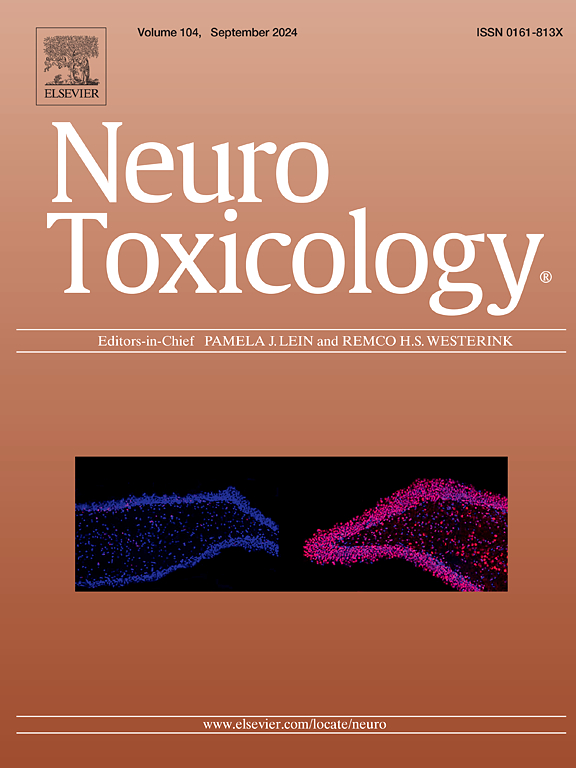Integrative behavior analysis, oxidative stress markers determination and molecular docking to investigate proconvulsant action of betalactamic carbapenems
IF 3.9
3区 医学
Q2 NEUROSCIENCES
引用次数: 0
Abstract
Carbapenems are broad-spectrum β-lactam antibiotics widely used in critical and hospitalized patients. They are usually well tolerated; however, under certain conditions, these drugs are associated with central nervous system toxicity and proconvulsant activity. Here, we investigated the proconvulsant action of different generation carbapenems: imipenem (IMI), meropenem (MERO), and ertapenem (ERTA) in mice through behavioral analysis. We also propose possible molecular mechanisms for this side effect through an integrative experimental and computational approach. For this, male mice received carbapenems at doses of 250 and 500 mg/kg, or saline, subcutaneously, for 7 days. On the last day, the pilocarpine-induced seizure test was performed. On the last day, the pilocarpine-induced seizure test was performed, and latency to the first seizure and latency of death were recorded. Subsequently, oxidative stress markers were measured in brain areas. Additionally, using the three-dimensional structure of the drugs, we performed computational target prediction and molecular docking calculations. IMI and MERO, at both tested doses, reduced seizure latency and death latency compared to pilocarpine group. This effect occurred only with the higher dose of ERTA (500 mg/kg). Furthermore, IMI increased lipid peroxidation in all brain areas, MERO in the hippocampus and prefrontal cortex, and ERTA only in the hippocampus. The three carbapenems increased nitrite/nitrate levels in all brain areas, while only IMI at 500 mg/kg decreased GSH. Computational studies predicted that GABAA receptor, Glutathione S-transferase Pi, Glutathione S-transferase Mu 1, and Glutathione S-transferase A2 could be promising targets for the CNS toxicity of carbapenems, related to their proconvulsant effect. Therefore, our data contribute to the current understanding of CNS toxicity associated with carbapenems and propose the participation of oxidative stress and the interaction with GABA and GSH synthesis systems in the molecular mechanism of their proconvulsant effect.
综合行为分析、氧化应激标志物测定及分子对接研究β -乙酰氨基碳青霉烯类药物的抗惊厥作用。
碳青霉烯类是广泛应用于危重和住院患者的广谱β-内酰胺类抗生素。它们通常是可以忍受的;然而,在某些情况下,这些药物与中枢神经系统毒性和惊厥前活性有关。本研究通过行为学分析研究了亚胺培南(IMI)、美罗培南(MERO)和厄他培南(ERTA)三种碳青霉烯类药物对小鼠的抗惊痫作用。我们还通过综合实验和计算方法提出了这种副作用的可能分子机制。为此,雄性小鼠皮下注射剂量分别为250和500mg/kg的碳青霉烯类药物或生理盐水,持续7天。最后一天进行匹罗卡品诱发癫痫发作试验。最后一天进行匹罗卡品致痫试验,记录首次发作潜伏期和死亡潜伏期。随后,在大脑区域测量氧化应激标记物。此外,利用药物的三维结构,我们进行了计算靶点预测和分子对接计算。与匹罗卡平组相比,IMI和MERO在两种测试剂量下都减少了癫痫发作潜伏期和死亡潜伏期。该效应仅在ERTA较高剂量(500mg/kg)时发生。此外,IMI增加了所有脑区的脂质过氧化,海马和前额叶皮层的MERO,而ERTA仅在海马区增加。三种碳青霉烯类药物增加了所有脑区的亚硝酸盐/硝酸盐水平,而只有500mg/kg的IMI降低了GSH。计算研究预测,GABAA受体、谷胱甘肽s -转移酶Pi、谷胱甘肽s -转移酶Mu 1和谷胱甘肽s -转移酶A2可能是碳青霉烯类药物中枢神经系统毒性的有希望的靶点,这与它们的前惊痫作用有关。因此,我们的数据有助于目前对碳青霉烯类相关的中枢神经系统毒性的理解,并提出氧化应激以及与GABA和GSH合成系统的相互作用参与了其前惊厥作用的分子机制。
本文章由计算机程序翻译,如有差异,请以英文原文为准。
求助全文
约1分钟内获得全文
求助全文
来源期刊

Neurotoxicology
医学-毒理学
CiteScore
6.80
自引率
5.90%
发文量
161
审稿时长
70 days
期刊介绍:
NeuroToxicology specializes in publishing the best peer-reviewed original research papers dealing with the effects of toxic substances on the nervous system of humans and experimental animals of all ages. The Journal emphasizes papers dealing with the neurotoxic effects of environmentally significant chemical hazards, manufactured drugs and naturally occurring compounds.
 求助内容:
求助内容: 应助结果提醒方式:
应助结果提醒方式:


